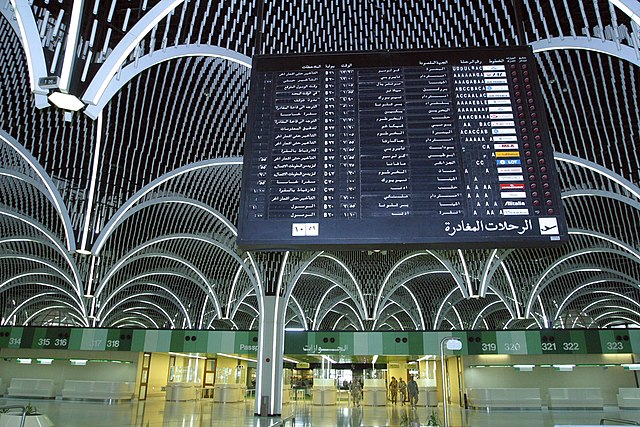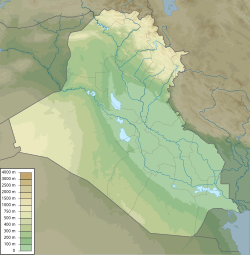Top Qs
Timeline
Chat
Perspective
Baghdad International Airport
Airport in Iraq From Wikipedia, the free encyclopedia
Remove ads
Baghdad International Airport (IATA: BGW, ICAO: ORBI) (Arabic: مطار بغداد الدولي, romanized: Maṭār Baġdād ad-Dawaliyy), previously known as Saddam International Airport (IATA: SDA, ICAO: ORBS) is an international airport serving Baghdad, the capital of Iraq. It is located in a suburb about 16 km (9.9 mi) west of the downtown in the Baghdad Governorate. Currently, it is the largest and busiest airport in Iraq, with approximately 8 million passengers annually, offering flights to more than 35 destinations.[3]
The construction of today's three terminals began in 1979, under the regime of Saddam Hussein. However, the inauguration of the airport was delayed during the Iran–Iraq War. The airport was opened in 1982. It ceased commercial operations after sanctions were imposed against Iraq during the Gulf War. Only a few planes operated, mainly carrying humanitarian aid. On 17 August 2000, the airport was reopened with commercial flights from Jordan, Syria and Lebanon.[4][5] During the invasion of Iraq in 2003, the airport was scene of heavy intense fighting between the United-States-led coalition forces and the Iraqi military. The airport fell in control of coalition forces and was closed for renovation. It adopted its current name and resumed operations. Though the airport and its vicinity were subjected to attacks and site of clashes between militants and the U.S. forces.
Remove ads
History
Summarize
Perspective
Before the airport
The Baghdad West Aerodrome, which would later be known as Al-Muthanna Airport was made available for civilian flights of Imperial Airways on April 1, 1929.[6]
Until 1970, Al Muthanna Airport or Muthenna Air Base was the main airport of Baghdad.[7]
Construction (Original)

The new airport was to be located 10 and a half miles southwest of the Al Muthanna Airport.[8]
Work began on the airport in August 1965 due to the older Baghdad West Airport declining in passenger numbers due to its lack of facilities, and the runway (now Runway 15R/33L) and apron had been completed by early 1966. An interim passenger building was to be completed initially, before the construction of a larger airport terminal, and when the new terminal would be completed, the interim terminal would be converted into a cargo terminal. Originally, the airport was supposed to be completed by 1968. The airport cost £15-20 million.[8]

The interim terminal contained a restaurant and 2 floors, airline offices, a combined transit and departure lounge, an arrival lounge, customs’ halls and a large concourse. At ground level, the terminal had an area of 43,000 square feet.[8]
The newer terminal was to have a single pier handling 8 aircraft, and the interim terminal, now a cargo terminal would have 5 extra aircraft parking stands next to it. The airport complex was to have 25 buildings and facilities, such as the main terminal, the Iraqi Airways headquarters, the control and communications building, and the cargo terminal once the plan would be fully completed. The control and communications building was to be located 3,300 feet northwest of the terminal. It would be a two-story building with a central tower containing the control room. The HQ of Iraqi Airways was to have 8 floors consisting largely of offices and two single-story units, one of which containing a staff canteen and kitchen while the other having welfare facilities. A massive hangar built for Iraqi Airways would be built, it would be built from reinforced concrete with giant cantilever beams and have an area of 54,000 square feet. It would have multiple workshops and stores together with all the necessary process shops for the maintenance and servicing of modern aircraft. An Iraqi Airways operations wing would also be built as a two story building. Meanwhile, a 3 lane highway was built to access the airport and the entire project was the responsibility of the Iraqi Director-General of Roads and Bridges. All of these facilities would make the airport capable of being one of the best in the Middle East.[8]
Sir Basil Spence designed the never built permanent terminal with 8 gates as a Consultant Architect for the engineering firm Sir Alexander Gibb & Partners.[9]
A Romanian state enterprise, Technoexport, was involved in performing all the main contract work other than the radio installations and the electronics.[8]
The plans for the permanent terminal with 1 pier with 8 aircraft gates was cancelled and shelved, but the original illustrations of both the interim terminal and the terminal are archived. The illustrations were made in 1967. The building would have been a rectangular block with a huge canopy porch and large pyramid-shaped skylights. A distinctive crescent-shaped sculptural motif with square-patterned tiles on its underside was planned for the roof. Spence was interested in adapting ancient forms of Sumerian writing to achieve a texture on the walls of the airport. He wanted the interior to be largely of luxurious marble stone but by 1969 was concerned that due to spiralling costs this might have to be abandoned in favour of local materials.[9]
Opening
Contrary to popular belief, in January 1970, the airport opened as Baghdad International Airport with one 10,827 foot concrete runway (now 15R/33L).[10]
The airport handled 26 airlines in 1978 and was the main base of Iraqi Airways, the IATA code was BGW and the ICAO code was ORBB.[10]
Expansion
The new terminals were developed under a consortium led by French company Spie Batignolles under an agreement made in 1979.[11] The Iran–Iraq War delayed full opening of the new airport terminals until 1982.[11] It was renamed as Saddam International Airport, bearing the name of then-Iraqi President Saddam Hussein.[11]
Closer to Baghdad than the older runway, a new runway, 15L/33R begun construction with a length of 13,123 feet or 4,000 meters.
The access road to the interim terminal was partially demolished so that Runway 15L/33R could be built.
Most of Baghdad's civilian flights stopped in 1991,[12] when the United Nations imposed restrictions on Iraq after its invasion of Kuwait. After the Persian Gulf War, a no-fly zone imposed on Iraq by the United States and the United Kingdom meant that Iraqi Airways was only able to continue domestic flights for limited periods.[citation needed] Occasional international charter flights carrying medicine, aid workers, and government officials were allowed into Baghdad.[13] Royal Jordanian Airlines operated regular flights from Amman to Baghdad.[citation needed]
On August 17, 2000, the airport was officially opened to civilian flights. Minister of Transport Ahmad Murtada said that:
And we are expecting the arrival of aircraft. The embargo has prevented Iraqi citizens from using the airport for 10 years. There is no international resolution banning flights to Iraq. It is a US-British-Zionist decision that is neither lawful, humane nor fair.
— Ahmed Murtada
2003–2005 (U.S. occupation)


In 2003, United States-led Coalition forces invaded Iraq. In early April, they moved into Baghdad, took control of the airport, and changed its name to the original name of the airport, Baghdad International Airport.[14] The ICAO code for the airport consequently changed from ORBS to ORBI. The IATA code also changed from SDA to BGW, which had previously referred to all Baghdad airports, and before that to Al Muthana Airport when Saddam Hussein was in power.
In July 2003, the airport resumed civilian flights for the first time since 1991.[12]

Civilian control of the airport was returned to the Iraqi Government from the Coalition Provisional Authority in 2004.[citation needed]
2005–2011
Sather Air Base – the American base on the west side of the airport – came under periodic rocket fire from Baghdad. On 6 December 2006, a 107mm rocket attack landed 30 yards (27 meters) from a parked C-5A aircraft, puncturing it with scores of shrapnel holes.[citation needed]
Terminal C was refreshed with three active gate areas for carriers operating from the airport.[citation needed]
2012-Present
Baghdad Airport Road, connecting the airport to the Green Zone, once a dangerous route full of IEDs, was refurbished in 2014 with palm trees, manicured lawns, and a fountain, with Turkish assistance.[15]
Since the end of the war, the region surrounding the airport alongside the Airport Road, has emerged as an investment destination in Baghdad.

On 1 May 2023, the Iraqi government under Mohammed Shia' Al Sudani approved plans to enhance services with the intention of launching an expansion project in the development of Baghdad Airport in the second half of 2023. In 2024, the airport reached the final stage of its expansion plan, according to the International Finance Corporation.
Remove ads
Military use
A separate enclave within the airport houses the New Al Muthana Air Base, where the Iraqi Air Force's 23rd Squadron is based, operating three Lockheed C-130E Hercules transport aircraft. The base is also home to a number of Sukhoi Su-25 attack aircraft.[16]
Sather Air Base, or Camp Sather, was a United States Air Force base on the west side of the airport from 2003 to 2011. It was named in memory of Combat Controller Staff Sergeant Scott Sather, the first enlisted airman to die in Operation Iraqi Freedom. Sather was awarded the Bronze Star Medal with Valor for his leadership of a 24th Special Tactics Squadron reconnaissance task force during the initial stages of the 2003 U.S. invasion.[17]
Remove ads
Airport developments
On 18 May 2010, plans were unveiled for an expansion of Baghdad International Airport, doubling its capacity to 15 million passengers per year. The expansion, to be funded by foreign investors, was to include construction of three new terminals and refurbishment of the existing three, each of which would accommodate 2.5 million passengers annually.[18]
Airlines and destinations
Passenger
Cargo

Remove ads
Statistics
Source: COSIT. Air Transport Activity Statistics, years 2015,[46] 2016,[47] 2017,[48] 2018,[49] 2019,[50] 2020,[51] 2021[52] and 2022.[53]
Historical Statistics from “Airports of the World”.[10]
*Rounded figure
Remove ads
Incidents and accidents
- In February 1991, five aircraft, comprising three Iraqi Government executive jets, plus two Iraqi Airways Tupolev Tu-124Vs (YI-AEL and YI-AEY), were destroyed on the ground at Saddam International Airport by US or allied bombs during the Gulf War.[54][55][56][57][58]
- In June 2000, two Saudi former military officers boarded a plane bound for London and diverted it to Baghdad. They wanted to claim asylum in Iraq, but Iraqi authorities later deported them to Saudi Arabia.[59]
- On 22 November 2003, a European Air Transport Airbus A300B4 freighter, registered OO-DLL, operating on behalf of DHL Aviation, was hit by an SA-14 'Grail' missile shortly after takeoff. The airplane lost hydraulic pressure, causing a loss of control. After extending the landing gear to create more drag, the crew piloted the plane using differences in engine thrust and landed the plane with minimal further damage. All three crew survived. After the incident, civilian planes took to routinely performing corkscrew landings to minimise the risk of being hit by surface weapons.[60]
- On 26 January 2015, a Flydubai Boeing 737-800 flying from Dubai to Baghdad with 154 passengers on board was hit by small-arms fire on approach to Baghdad International Airport. The plane landed safely.[61] One passenger was injured when at least three bullets struck the plane. After the incident, UAE carriers FlyDubai and Emirates suspended their flights from Dubai to Baghdad. Flights by Turkish Airlines and Royal Jordanian were also temporarily suspended.[26]
- On 3 January 2020, a U.S. drone strike killed Qasem Soleimani, leader of Iran's Quds Force, and Abu Mahdi al-Muhandis, deputy commander of the Popular Mobilization Forces, as their convoy left the airport on or near Baghdad Airport Road.[62][63][64]
Remove ads
See also
References
External links
Wikiwand - on
Seamless Wikipedia browsing. On steroids.
Remove ads




